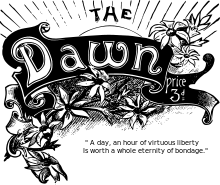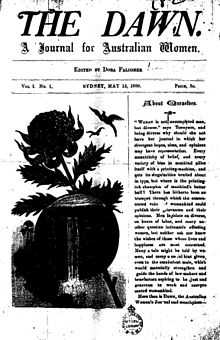The Dawn (feminist magazine)
|
Front cover of the first edition, 15 May 1888 | |
| Editor | Louisa Lawson |
|---|---|
| First issue | 1888 |
| Final issue | 1905 |
| Country | Australia |
| Language | English |
The Dawn: A Journal for Australian Women was an early feminist journal published monthly in Sydney, Australia between 1888 and 1905.[1] It was first published 15 May 1888 by Louisa Lawson using the pen name of Dora Falconer.[2] The subtitle was later changed to A Journal for the Household.[3] It became the official publication of the Australian Federation of Women Voters.[4]
History
Louisa Lawson left her husband in 1883 and relocated her family to Sydney. There she supported her children through various jobs, including working as a seamstress and running a boarding house. During this period she was introduced to women's suffrage. In 1887 she purchased the Republican, a journal dedicated to Australian independence and, the following year, in 1888, she founded the Dawn.[5]
From the outset the Dawn was intended as a mouthpiece for women. In the first edition, Louisa Lawson, writing under the name of Dora Falconer, wrote:
Every eccentricity of belief, and every variety of bias in mankind allies itself with a printing machine, and gets its singularities bruited about in type, but where is the printing-ink champion of mankind's better half? There has hitherto been no trumpet through which the concentrated voice of womankind could publish their grievances and their opinions ... Here then is Dawn, the Australian Woman's Journal and mouthpiece.—Dora Falconer, 15 May 1888[6]
Nevertheless, the Dawn soon hit opposition: the Dawn was produced by an all-women team of editors and printers, and this fact angered trade unionists in the New South Wales Typographical Association,[7] in part because women were paid substantially less than men.[8][9] In fighting the Dawn, the association argued that the discrepancies in pay were such that men would be unable to compete, as women would be "… able to work for half the wages a man would require to keep himself and family in comfort and respectability",[10] as well as arguing that the work was too dangerous for women to engage in.[11] The association attempted to boycott the publication, and at one stage a member visited their offices to "harangue the staff" – only to be removed after having had a bucket of water thrown on them by Lawson.[12][13] Lawson won the battle through patience and "stern resistance" – eventually the boycott lost momentum, and the Dawn continued as it had before.[14]

In spite of the early disputes, the Dawn proved to be successful. Lawson's ability to attract significant advertising was key to the Dawn 's success, (Pearce noted that up to half of the magazine was devoted to advertising), as was her efforts to promote the work: Lawson encouraged children to register subscribers by offering prizes, and ran regular competitions within the magazine to increase circulation and retain subscribers.[15] Her efforts were to grant the Dawn a much longer life than other, contemporary, Australian feminist magazines.[16]
The final issue of the Dawn was published in July 1905. Believing there was no-one suitable to carry on her work, Louisa Lawson "ended her paper as she started it, quite upon her own responsibility."[17] Her poor health, resulting from a Tram Accident and legal dispute regarding her mail bag fastener invention were key factors in her decision.[5]
Content and themes
Lawson's working-class background was reflected in the Dawn, in that it aimed at a wider audience than the middle class. The price was low enough to appeal to those from the working classes, and the content similarly reflected this aim: as identified by Aitken, the Dawn included household hints that were "aimed at women running a home without servants".[18] Along with those hints came editorials, articles, columns, correspondence, poetry and short stories, material for children and fashion.[19] The Dawn was deliberately aimed at the whole household, and the political messages were interwoven with the other content.[16]
To some extent, the Dawn existed in opposition to the The Bulletin, another magazine of the period, but one aimed squarely at men – each produced radically different views of the role of men and women in society. While The Bulletin of the day has been described as depicting women as either "vain, conniving, … spendthrift [and] bent on entrapment" or as "bitter harridan[s]", the Dawn took a very different approach, depicting men in relation to home values, and arguing that the emancipation of women was necessary for the advancement of society.[20][21]
The Dawn tackled a number of issues of interest to women. These included the use of corsets, female suffrage, the overworking of women, and a woman's role within marriage.[22] In addition, Lawson, through the pages of the Dawn, was unusual in being the only leader of the Australian women's movement who repeatedly raised the issue of spousal abuse. Within the Dawn she "offered a far-reaching critique of power relations within marriage", which was careful not to depict women as simple passive victims, but instead encouraged women to fight and escape their situation.[18] Sheridan noted that this range of issues granted the Dawn much of its strength – Lawson did not shy away from domestic or public issues, covering both through the pages of the magazine.[23] Cousins has further argued that not only did the Dawn construct a certain view of femininity to mount the case for female suffrage, but also one of masculinity. The Dawn presented a distinct and often unflattering view of `manhood' to their readers in an attempt to gain positions of power for women not just in the public sphere, but also within the sanctity of the domestic realm. In doing so, the writers were advocating a significant shift in the power relations that operated between men and women.[24]
Influence
The Dawn was widely read both within Australia and internationally, and led Scott to describe Lawson as the "earliest Australian woman to be influential" within the British suffrage movement.[25] Domestically, the success of the Dawn led to the founding of the "Dawn Club" in 1889,[26] and the Dawn "helped to pave the way for women's magazines in Australia", validating the experiences of women, their work and their writing.[27]
Availability
The magazine is available on microfiche in many large Australian libraries.[28] However, a campaign to increase its availability by raising sufficient funds to see the Dawn digitised by the National Library of Australia was launched in 2011 by Donna Benjamin. The campaign succeeded, raising sufficient funds prior to the end of International Women's Day 2011 to ensure the Dawn will be added to Trove.[29][30]
The digital version became available on International Women's Day 2012.[31][32]
See also
List of newspapers in New South Wales
Footnotes
- ↑ Heywood 2009
- ↑ "News and Notes". The West Australian (Perth: National Library of Australia). 15 June 1888. p. 3. Retrieved 22 February 2011.
- ↑ "A Poet's Mother—Louisa Lawson". The Morning Bulletin (Rockhampton, Qld.). 27 October 1896. p. 6. Retrieved 22 February 2011.
- ↑ "Guide to the Records of the Australian Federation of Women Voters". Catalogue – Manuscripts collection. National Library of Australia. 2002. Retrieved 10 May 2014.
- ↑ 5.0 5.1 Rappaport 2001, p. 390
- ↑ Falconer 1888, p. 1
- ↑ Women Shaping the Nation: Victorian Honour Roll of Women: Volume 1, 2001, accessed 22 February 2011.
- ↑ "Female Compositors". The Sydney Morning Herald. 9 August 1890. p. 4. Retrieved 22 February 2011.
- ↑ Previously, the union had successfully waged a campaign against The Word of Grace, which had similarly (although not exclusively) employed women as compositors – the union's actions in supporting a strike by the male staff saw the women withdrawn (Nicol 1979).
- ↑ "The Emancipation of Women" Australasian Typographical Journal (June, 1889) in Hagan 1965, p. 20
- ↑ Matthews 1998, p. 210
- ↑ Nicol 1979, p. 20
- ↑ Although Lawson was successful in publishing the Dawn, the Typographical Association refused to allow women to join the union until 1916, and even then only as part of a separate "Women and Girls" section (Hagan 1965).
- ↑ Matthews 1998, pp. 216, 220
- ↑ Pearce 1997, pp. 14–15
- ↑ 16.0 16.1 Pearce 1997, p. 15
- ↑ Falconer 1905, p. 6
- ↑ 18.0 18.1 Aitken 2007, pp. 121–2
- ↑ Pearce 1997, p. 13
- ↑ Lee 1996
- ↑ Devereux 1999, pp. 178–9
- ↑ Pearce 1997, pp. 13, 15–17
- ↑ Sheridan 1995, p. 79, in Pearce 1997, p. 20
- ↑ Cousins 1999
- ↑ Scott 2003, p. 13
- ↑ Radi 1986
- ↑ Spender 1988, p. 140
- ↑ Trove: The Dawn, accessed 22 February 2011.
- ↑ Ryan 2011
- ↑ Benjamin 2011
- ↑ "The Dawn rises again". National Library of Australia. 8 March 2012. Retrieved 19 May 2014.
- ↑ Ross, Monique (8 March 2012). "New dawn for historic suffragette journal". ABC News.
References
- Aitken, Jo (2007). "'The Horrors of Matrimony among the Masses': Feminist Representations of Wife Beating in England and Australia, 1870–1914" (PDF). Journal of Women's History 19 (4): 121–122. doi:10.1353/jowh.2007.0072.
- Benjamin, Donna (2011). "Digitise The Dawn". Australian Feminist Studies 26 (68): 225–227. doi:10.1080/08164649.2011.574601.
- Cousins, Sara (1999). "'Drunken, Selfish, "Boors"? Images of Masculinity in the Dawn". Hecate 25 (2).
- Devereux, Cecily (March–April 1999). "New woman, new world: Maternal feminism and the new imperialism in the white settler colonies". Women's Studies International Forum (ScienceDirect) 22 (2): 178–179. doi:10.1016/S0277-5395(99)00005-9.
- Falconer, Dora (15 May 1888). "About Ourselves". The Dawn 1 (1): 1.
- Falconer, Dora (1 July 1905). "An Explanation.". The Dawn (Sydney, NSW : 1888–1905) (Sydney: National Library of Australia): 6. Retrieved 7 March 2012.
- Hagan, J. (May 1965). "An Incident at The Dawn". Labour History (8): 19–21. JSTOR 27507777.
- Heywood, Anne (4 May 2009). "The Dawn: a journal for Australian women (1888–1905)". The Australian Women's Register. Retrieved 9 March 2011.
- Lee, Christopher (1996). "Looking for Mr Backbone: The Politics of Gender in the work of Henry Lawson". In Stewart, Ken. The 1890's: Australian Literature and Literary Culture. University of Queensland Press. ISBN 0-7022-2867-2.
- Matthews, Brian (1998). Louisa. University of Queensland Press. ISBN 0-7022-3071-5.
- Nicol, W. (May 1979). "Women and the Trade Union Movement in New South Wales: 1890–1900". Labour History (36): 20. JSTOR 27508350.
- Pearce, Sharyn (1997). "From bush battler to city editor: Louisa Lawson and the Dawn". Journal of Australian Studies 21 (54): 12–21. doi:10.1080/14443059709387332.
- Radi, Heather (1986). "Lawson, Louisa (1848–1920)". Australian Dictionary of Biography 10. Canberra: Australian National University. Retrieved 10 March 2011.
- Rappaport, Helen (2001). "Lawson, Louisa". Encyclopedia of Women Social Reformers 1. pp. 389–390. ISBN 1-57607-101-4.
- Ryan, Rosanna (9 March 2011). "Suffragette journal set to join digital age". ABC News (Australian Broadcasting Corporation). Retrieved 10 March 2009.
- Scott, Myra (2003). How Australia led the way: Dora Meeson Coates and British suffrage. Commonwealth Office of the Status of Women. ISBN 1-877042-40-4. Retrieved 10 March 2011.
- Sheridan, Susan (1995). Along the Faultlines: Sex, Race and Nation in Australian Women's Writing 1880s–1930s. St. Leonards, NSW: Allen & Unwin. ISBN 1-86373-867-3.
- Spender, Dale (1988). "Ch 10: Woman to Woman". Writing a new world: two centuries of Australian women writers. Spinifex Press. ISBN 978-0-86358-172-4.
